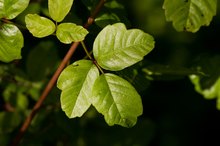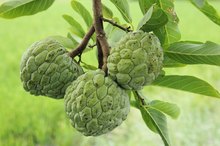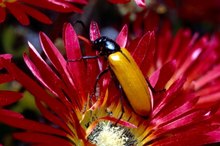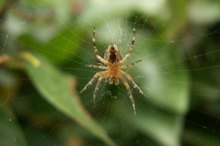Common Vines That Cause Skin Rashes
A rash caused by skin contact with an allergen is referred to by the medical term "allergic contact dermatitis." Allergic contact dermatitis occurs when the body identifies a foreign substance as being a potential threat and responds by releasing chemicals called histamines. Histamines increase blood vessel permeability, allowing fluid containing white blood cells to flow into areas affected by the allergen. This results in the swelling, redness and itch characteristic of an allergic skin rash. Several vining plants have been identified to cause allergic reactions.
Poison Ivy
The poison ivy plant, known by the botanical name Rhus radicans, is the most well-known vine that commonly causes allergic contact dermatitis. The red, itchy blisters of a poison ivy reaction result when the skin brushes up against the leaves of the plant, leaving a sticky resin called urushiol deposited on the skin’s surface. Urushiol exposure can also result from touching the stem or root of the plant, or even from brushing against another object that has touched the plant, such as firewood, or a pet’s fur, according to the Mayo Clinic.
Urushiol remains persistently on an object until it is washed, so clothing that has been exposed to urushiol, put away, and worn a year later can cause a poison ivy rash 1.
The poison ivy plant is commonly found forests. It can grow as a vine, plant or bush form. It has green leaves that may turn red in autumn. These leaves occur in sets of 3, and may have saw-toothed, or smooth edges.
- The poison ivy plant, known by the botanical name Rhus radicans, is the most well-known vine that commonly causes allergic contact dermatitis.
- The red, itchy blisters of a poison ivy reaction result when the skin brushes up against the leaves of the plant, leaving a sticky resin called urushiol deposited on the skin’s surface.
Poison Oak
Never Eat These 3 Things If You've Ever Had Poison Oak or Poison Ivy
Learn More
Poison oak, or Toxiconfrendron diversilobum, takes three different forms: shrub, ground cover or vine. It is part of the same family of plants as poison ivy, and similarly, has leaflets grouped in sets of three. The surfaces of poison oak leaves are shiny, and the edges can be lobed or smooth. Poison oak leaves are green in the spring and summer and turn red in autumn.
As with poison ivy, poison oak contains urushiol. Humboldt University notes that most of the population is allergic to this resin, with only 10 to 25 percent of people unaffected by urushiol exposure 3.
- Poison oak, or Toxiconfrendron diversilobum, takes three different forms: shrub, ground cover or vine.
- As with poison ivy, poison oak contains urushiol.
Kiwi Vine
DermNet NZ reports that the vines that bear the cute, fuzzy fruit known as kiwis can cause a no-so-cute case of allergic contact dermatitis 2. The kiwi plant, or Actinidia chinensis, contains an allergen called proteinase actinidin. In addition to allergic contact dermatitis, contact with kiwis and kiwi vines can cause:
- urticaria
- or hives,
- irritant contact dermatitis
- which results when an irritant disrupts the skin's natural protective barrier
Related Articles
References
- Mayo Clinic: Poison Ivy Rash
- DermNet NZ: Kiwifruit
- Humboldt University: The Poison Oak Page
- Prok L, McGovern T. Patient education: Poison ivy (Beyond the Basics). UpToDate. Updated March 25, 2019.
- American Academy of Dermatology. (2018). Poison ivy, oak, and sumac. https://www.aad.org/public/diseases/itchy-skin/poison-ivy-oak-and-sumac
- U.S. Food and Drug Administration. (2016). Outsmarting Poison Ivy and Its Cousins. https://www.fda.gov/ForConsumers/ConsumerUpdates/ucm049342.htm
- Boston Children's Hospital. Poison Ivy, Poison Oak and Poison Sumac.
- American Academy of Dermatology. Poison Ivy, Oak, and Sumac: Who gets a rash and is it contagious?
- Prok L, McGovern T. Patient education: Poison ivy (Beyond the Basics). Updated March 25, 2019.
- U.S. Food and Drug Administration. Outsmarting Poison Ivy and Other Poisonous Plants. Updated August 6, 2016.
- Porter R. Poison Ivy, Poison Oak and Poison Sumac. National Capital Poison Center.
- Usatine RP, Riojas M. Diagnosis and management of contact dermatitis. Am Fam Physician. 2010;82(3):249-55.
- MedlinePlus. Bentoquatam Topical. Updated February 15, 2018.
- American Academy of Dermatology. (2018). Poison ivy, oak, and sumac.
- Curtis G, Lewis AC. Treatment of severe poison ivy: a randomized, controlled trial of long versus short course oral prednisone. J Clin Med Res. 2014 Dec;6(6):429-34. doi: 10.14740/jocmr1855w.
- Habif TP. Clinical Dermatology: A Color Guide to Diagnosis and Therapy. Elsevier; 2016.
- U.S. Food and Drug Administration. (2016). Outsmarting Poison Ivy and Its Cousins.
Writer Bio
For 15 years, Charis Grey's award-winning work has appeared in film, television, newspapers, magazines and on the Internet. She has worked as a story editor on the CBS drama "Flashpoint" and her work appears bimonthly in "The Driver Magazine." She has a Bachelor of Science in biology and a doctorate in chiropractic medicine from Palmer College.









